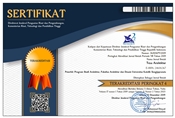The House Types of Settlements in The RiverBank Wetland; The Factual Conditions and The Recommendations
Abstract
Keywords
Full Text:
PDFReferences
Al-Shams, Raad, A., Ngah, K., Zakaria, Z., Noordin, N., and Hilmie, M., Sawal, M., 2013. Waterfront Development within the Urban Design and Public SpaceFramework in Malaysia. Asian Social Science 9(10).
Conradin, F, and Buchli, R., 2004. The Zurich Stream Day-Lighting Program. In Enhancing Urban Environment by Environmental Upgrading and Restoration. Marsalek, Jiri, Szutruhar, Daniel, Giulianelli, Mario, and Urbonas, Ben, eds. Pp. 265–276. NATO Science Series, v. 43. Dordrecht . Boston: Kluwer Academic Publishers.
Echols, Stuart P., and Hala. F. Nassar, 2006. Canals and Lakes of Cairo: Influence of Traditional Water System on the Development of Urban Form. Urban Design International 11(3–4): 203–212.
Hooimeijer, Fransje, and W. van der Toorn Vrijthoff, eds. ,2008. More Urban Water: Design and Management of Dutch Water Cities. Urban Water Series, v. 10. London . New York: Taylor & Francis.
Imanuddin, Yulianto P., Prihatmaji, 2017. Rumah Inkremental Melayu Di Tepi Sungai Siak, Pekanbaru: Penerapan Struktur Dan Material Berbasis Kemampuan Masyarakat Di Area Banjir. Tesa Arsitektur 2: 64–77.
Kay, James J., Regier, H., Boyle, M., and Francis, G., 1999. An Ecosystem Approach for Sustainability: Addressing the Challenge of Complexity. Futures 31(7): 721–742.
Lahdelma, Risto, Pekka Salminen, and Joonas Hokkanen, 2000. Using Multicriteria Methods in Environmental Planning and Management. Environmental Management 26(6): 595–605.
Mahan, Brent L., Stephen Polasky, and Richard M. Adams, 2000. Valuing Urban Wetlands: A Property Price Approach. Land Economics: 100–113.
Marsalek, Jiri, Day, Elizabeth, and Larson, Elizabeth, 2008. Strategies, Policy and Regulations Integrating Protection and Rehabilitation of Aquatic Habitat in Urban Water Management. In Aquatic Habitats in Sustainable Urban Water Management: Science, Policy and Practice. Iwona Wagner, J. Marsalek, and Pascal Breil, eds. Pp. 25–42. Urban Water Series, v. 4. Paris : Leiden . [London] . [New York]: UNESCO . Taylor & Francis.
Mitsch, William J., and James G. Gosselink. 2015. Wetlands. Fifth edition. Hoboken, NJ: John Wiley and Sons, Inc.
Nakamura, Keigo, Klement Tocner, and Kunihiko Amano. 2006. River and Wetland Restoration: Lessons from Japan. BioScience 56(5): 419–430.
Nassauer, Joan Iverson, Sandra E. Kosek, and Robert C. Corry, 2001. Meeting Public Expectations with Ecological Innovation in Riparian Landscapes. Wetlands 24 (4), December 2004, pp. 756–765.
Novotny, Vladimir, John Ahern, and Paul Brown, 2010. Water Centric Sustainable Communities: Planning, Retrofitting, and Building the next Urban Environment. Hoboken, N.J: Wiley.
Platt, Rutherford, 2006. Urban Watershed Management Sustainability, One Stream at A Time. Environment 48(4): 26–43.
Remondi, Federica, Paolo Burlando, and Derek Vollmer, 2016. Exploring the Hydrological Impact of Increasing Urbanisation on a Tropical River Catchment of the Metropolitan Jakarta, Indonesia. Sustainable Cities and Society 20: 210–221.
Shandas, Vivek, 2007. An Empirical Study of Streamside Landowners’ Interest in Riparian Conservation. American Planning Association. Journal of the American Planning Association 73(2): 173–185.
Stander, Emilie K., and Joan G. Ehrenfeld, 2010. Urban Riparian Function. Urban Ecosystem Ecology (urban ecosysteme): 253–275.
Vollmer, Derek, and Adrienne Grêt-Regamey, 2013.Rivers as Municipal Infrastructure: Demand for Environmental Services in Informal Settlements along an Indonesian River. Global Environmental Change 23(6): 1542–1555.
Wagner, Iwona, J. Marsalek, Pascal Breil, International Hydrological Programme, and Unesco, eds.., 2008. Aquatic Habitats in Sustainable Urban Water Management: Science, Policy and Practice. Urban Water Series, v. 4. Paris : Leiden . [London] . [New York]: UNESCO . Taylor & Francis
DOI: https://doi.org/10.24167/tesa.v16i2.1373
ISSN 1410-6094 (Print) | ISSN 2460-6367 (Media Online) | View My Stats

This work is licensed under a Creative Commons Attribution 4.0 International License.








